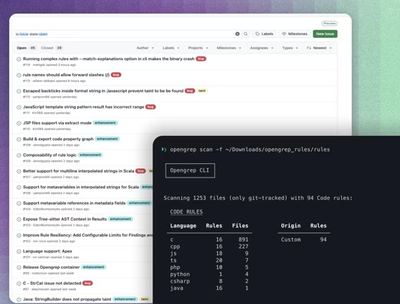What is xterm?
xterm is a terminal emulator library that can be used to create terminal interfaces in web applications. It provides a way to embed a terminal in a web page, allowing users to interact with a command-line interface directly from their browser.
What are xterm's main functionalities?
Basic Terminal Initialization
This code initializes a basic terminal instance and attaches it to a DOM element with the ID 'terminal-container'.
const { Terminal } = require('xterm');
const terminal = new Terminal();
terminal.open(document.getElementById('terminal-container'));
Customizing Terminal Appearance
This code demonstrates how to customize the appearance of the terminal, including the number of columns and rows, as well as the theme colors for the background and foreground.
const { Terminal } = require('xterm');
const terminal = new Terminal({
cols: 80,
rows: 24,
theme: {
background: '#1e1e1e',
foreground: '#ffffff'
}
});
terminal.open(document.getElementById('terminal-container'));
Handling Terminal Input
This code sets up an event listener to handle user input in the terminal. The input data is logged to the console.
const { Terminal } = require('xterm');
const terminal = new Terminal();
terminal.open(document.getElementById('terminal-container'));
terminal.onData(data => {
console.log('User input:', data);
});
Writing Data to Terminal
This code demonstrates how to write data to the terminal. The text 'Hello, World!' is written to the terminal, followed by a carriage return and newline.
const { Terminal } = require('xterm');
const terminal = new Terminal();
terminal.open(document.getElementById('terminal-container'));
terminal.write('Hello, World!\r\n');
Other packages similar to xterm
blessed
Blessed is a curses-like library for creating terminal user interfaces in Node.js. It provides a higher-level abstraction for building complex terminal applications, including support for widgets like buttons, text boxes, and more. Compared to xterm, blessed is more focused on creating full-fledged terminal applications rather than embedding a terminal emulator in a web page.
terminal-kit
Terminal-kit is a comprehensive library for creating terminal applications in Node.js. It offers a wide range of features, including support for colors, styles, input handling, and more. Terminal-kit is similar to blessed in that it is designed for building terminal applications, but it provides more low-level control and flexibility. Unlike xterm, terminal-kit is not focused on web-based terminal emulation.
node-pty
Node-pty is a library that provides bindings to pseudo terminals (PTYs) in Node.js. It allows you to spawn and interact with terminal processes programmatically. While node-pty does not provide a terminal emulator like xterm, it can be used in conjunction with xterm to handle the backend process management for a web-based terminal interface.



Xterm.js is a front-end component written in TypeScript that lets applications bring fully-featured terminals to their users in the browser. It's used by popular projects such as VS Code, Hyper and Theia.
Features
- Terminal apps just work: Xterm.js works with most terminal apps such as
bash, vim and tmux, this includes support for curses-based apps and mouse event support. - Perfomant: Xterm.js is really fast, it even includes a GPU-accelerated renderer.
- Rich unicode support: Supports CJK, emojis and IMEs.
- Self-contained: Requires zero dependencies to work.
- Accessible: Screen reader support can be turned on using the
screenReaderMode option. - And much more: Links, theming, addons, well documented API, etc.
What xterm.js is not
- Xterm.js is not a terminal application that you can download and use on your computer.
- Xterm.js is not
bash. Xterm.js can be connected to processes like bash and let you interact with them (provide input, receive output).
Getting Started
First you need to install the module, we ship exclusively through npm so you need that installed and then add xterm.js as a dependency by running:
npm install xterm
To start using xterm.js on your browser, add the xterm.js and xterm.css to the head of your html page. Then create a <div id="terminal"></div> onto which xterm can attach itself. Finally instantiate the Terminal object and then call the open function with the DOM object of the div.
<!doctype html>
<html>
<head>
<link rel="stylesheet" href="node_modules/xterm/dist/xterm.css" />
<script src="node_modules/xterm/dist/xterm.js"></script>
</head>
<body>
<div id="terminal"></div>
<script>
var term = new Terminal();
term.open(document.getElementById('terminal'));
term.write('Hello from \x1B[1;3;31mxterm.js\x1B[0m $ ')
</script>
</body>
</html>
Importing
The recommended way to load xterm.js is via the ES6 module syntax:
import { Terminal } from 'xterm';
Addons
Addons are JavaScript modules that extend the Terminal prototype with new methods and attributes to provide additional functionality. There are a handful available in the main repository in the src/addons directory and you can even write your own by using the public API.
To use an addon, just import the JavaScript module and pass it to Terminal's applyAddon method:
import { Terminal } from 'xterm';
import * as fit from 'xterm/lib/addons/fit/fit';
Terminal.applyAddon(fit);
var xterm = new Terminal();
xterm.fit();
You will also need to include the addon's CSS file if it has one in the folder.
Importing Addons in TypeScript
There are currently no typings for addons if they are accessed via extending Terminal prototype, so you will need to upcast if using TypeScript, eg. (xterm as any).fit(). Alternatively, you can import the addon function and enhance the terminal on demand. This has better typing support and is friendly to treeshaking.
import { Terminal } from 'xterm';
import { fit } from 'xterm/lib/addons/fit/fit';
const xterm = new Terminal();
fit(xterm);
Browser Support
Since xterm.js is typically implemented as a developer tool, only modern browsers are supported officially. Here is a list of the versions we aim to support:
- Chrome latest
- Edge latest
- Firefox latest
- Safari latest
- IE11
Xterm.js works seamlessly in Electron apps and may even work on earlier versions of the browsers, these are the versions we strive to keep working.
API
The full API for xterm.js is contained within the TypeScript declaration file, use the branch/tag picker in GitHub (w) to navigate to the correct version of the API.
Note that some APIs are marked experimental, these are added to enable experimentation with new ideas without committing to support it like a normal semver API. Note that these APIs can change radically between versions so be sure to read release notes if you plan on using experimental APIs.
Real-world uses
Xterm.js is used in several world-class applications to provide great terminal experiences.
- SourceLair: In-browser IDE that provides its users with fully-featured Linux terminals based on xterm.js.
- Microsoft Visual Studio Code: Modern, versatile and powerful open source code editor that provides an integrated terminal based on xterm.js.
- ttyd: A command-line tool for sharing terminal over the web, with fully-featured terminal emulation based on xterm.js.
- Katacoda: Katacoda is an Interactive Learning Platform for software developers, covering the latest Cloud Native technologies.
- Eclipse Che: Developer workspace server, cloud IDE, and Eclipse next-generation IDE.
- Codenvy: Cloud workspaces for development teams.
- CoderPad: Online interviewing platform for programmers. Run code in many programming languages, with results displayed by xterm.js.
- WebSSH2: A web based SSH2 client using xterm.js, socket.io, and ssh2.
- Spyder Terminal: A full fledged system terminal embedded on Spyder IDE.
- Cloud Commander: Orthodox web file manager with console and editor.
- Codevolve: Online platform for interactive coding and web development courses. Live container-backed terminal uses xterm.js.
- RStudio: RStudio is an integrated development environment (IDE) for R.
- Terminal for Atom: A simple terminal for the Atom text editor.
- Eclipse Orion: A modern, open source software development environment that runs in the cloud. Code, deploy and run in the cloud.
- Gravitational Teleport: Gravitational Teleport is a modern SSH server for remotely accessing clusters of Linux servers via SSH or HTTPS.
- Hexlet: Practical programming courses (JavaScript, PHP, Unix, databases, functional programming). A steady path from the first line of code to the first job.
- Selenoid UI: Simple UI for the scallable golang implementation of Selenium Hub named Selenoid. We use XTerm for streaming logs over websockets from docker containers.
- Portainer: Simple management UI for Docker.
- SSHy: HTML5 Based SSHv2 Web Client with E2E encryption utilising xterm.js, SJCL & websockets.
- JupyterLab: An extensible computational environment for Jupyter, supporting interactive data science and scientific computing across all programming languages.
- Theia: Theia is a cloud & desktop IDE framework implemented in TypeScript.
- Opshell Ops Helper tool to make life easier working with AWS instances across multiple organizations.
- Proxmox VE: Proxmox VE is a complete open-source platform for enterprise virtualization. It uses xterm.js for container terminals and the host shell.
- Script Runner: Run scripts (or a shell) in Atom.
- Whack Whack Terminal: Terminal emulator for Visual Studio 2017.
- VTerm: Extensible terminal emulator based on Electron and React.
- electerm: electerm is a terminal/ssh/sftp client(mac, win, linux) based on electron/node-pty/xterm.
- Kubebox: Terminal console for Kubernetes clusters.
- Azure Cloud Shell: Azure Cloud Shell is a Microsoft-managed admin machine built on Azure, for Azure.
- atom-xterm: Atom plugin for providing terminals inside your Atom workspace.
- rtty: Access your terminals from anywhere via the web.
- Pisth: An SFTP and SSH client for iOS.
- abstruse: Abstruse CI is a continuous integration platform based on Node.JS and Docker.
- Azure Data Studio: A data management tool that enables working with SQL Server, Azure SQL DB and SQL DW from Windows, macOS and Linux.
- FreeMAN: A free, cross-platform file manager for power users.
- Fluent Terminal: A terminal emulator based on UWP and web technologies.
- Hyper: A terminal built on web technologies.
- Diag: A better way to troubleshoot problems faster. Capture, share and reapply troubleshooting knowledge so you can focus on solving problems that matter.
- GoTTY: A simple command line tool that shares your terminal as a web application based on xterm.js.
- genact: A nonsense activity generator.
- cPanel & WHM: The hosting platform of choice.
- Nutanix: Nutanix Enterprise Cloud uses xterm in the webssh functionality within Nutanix Calm, and is also looking to move our old noserial (termjs) functionality to xterm.js.
- SSH Web Client: SSH Web Client with PHP.
- Shellvault: The cloud-based SSH terminal you can access from anywhere.
- Juno: A flexible Julia IDE, based on Atom.
- webssh: Web based ssh client.
- info-beamer hosted: Uses xterm.js to manage digital signage devices from the web dashboard.
- Jumpserver: Jumpserver Luna project, Jumpserver is a bastion server project, Luna use xterm.js for web terminal emulation.
- LxdMosaic: Uses xterm.js to give terminal access to containers through LXD
- CodeInterview.io: A coding interview platform in 25+ languages and many web frameworks. Uses xterm.js to provide shell access.
- Bastillion: Bastillion is an open-source web-based SSH console that centrally manages administrative access to systems.
- PHP App Server: Create lightweight, installable almost-native applications for desktop OSes. ExecTerminal (nicely wraps the xterm.js Terminal), TerminalManager, and RunProcessSDK are self-contained, reusable ES5+ compliant Javascript components.
And much more...
Do you use xterm.js in your application as well? Please open a Pull Request to include it here. We would love to have it in our list. Note: Please add any new contributions to the end of the list only.
Releases
Xterm.js follows a monthly release cycle roughly.
All current and past releases are available on this repo's Releases page, you can view the high-level roadmap on the wiki and see what we're working on now by looking through Milestones.
Beta builds
Our CI releases beta builds to npm for every change that goes into master, install the latest beta build with:
npm install -S xterm@beta
These should generally be stable but some bugs may slip in, we recommend using the beta build primarily to test out new features and for verifying bug fixes.
Contributing
You can read the guide on the wiki to learn how to contribute and setup xterm.js for development.
License Agreement
If you contribute code to this project, you are implicitly allowing your code to be distributed under the MIT license. You are also implicitly verifying that all code is your original work.
Copyright (c) 2017-2019, The xterm.js authors (MIT License)
Copyright (c) 2014-2017, SourceLair, Private Company (www.sourcelair.com) (MIT License)
Copyright (c) 2012-2013, Christopher Jeffrey (MIT License)




